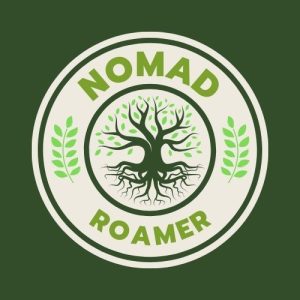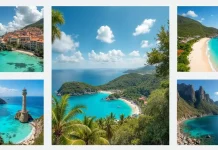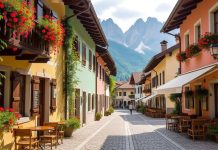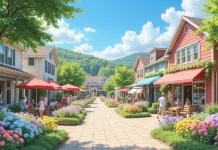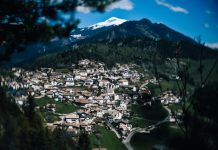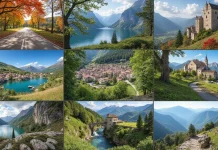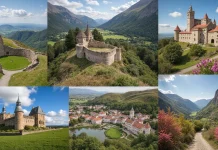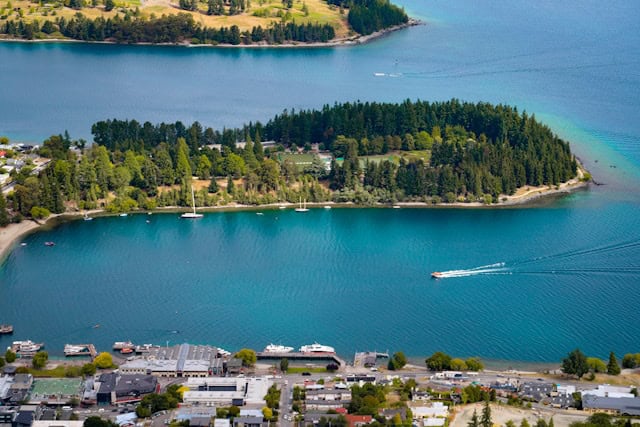The Enchanting Wine Regions of Bordeaux, France
The Left Bank: Médoc and Graves
Nestled along the river Gironde, the Left Bank is home to some of the most prestigious wine estates in the world. The Médoc region is synonymous with luxury wine châteaux like Château Lafite Rothschild and Château Margaux. These are estates where history and tradition meet the art of wine-making. A visit here often includes not only a tour of the facility and a sampling of their exquisite wines but also a stroll through the meticulously kept vineyards. The terroir here, dominated by gravel soils, is perfectly suited for Cabernet Sauvignon, leading to robust, tannic wines that age beautifully.
Graves, on the other hand, is diverse in its offerings. Here, both red and white wines shine, with properties like Château Haut-Brion leading the red wine game, while the whites are often aromatic and age-worthy, thanks to the region's unique blend of Sauvignon Blanc and Sémillon.
Visiting Suggestions
Plan ahead as many vineyards require reservations. Consider cycling between ch̢teaux to fully embrace the scenic beauty and the French countryside air. And don't skip the local cuisine Рa pairing of Bordeaux wines with regional dishes like duck confit or escargot is a must.
The Right Bank: Saint-Émilion and Pomerol
Cross the Gironde to explore the vineyards of Saint-Émilion and Pomerol, smaller yet equally influential areas. Saint-Émilion, a UNESCO World Heritage site, charms with its cobblestone streets and ancient monasteries. The wines here predominantly showcase Merlot, producing lush, opulent flavors. Don’t miss a tasting at Château Ausone or Château Cheval Blanc.
Pomerol, although smaller with no formal wine classification system, produces some of the world's most sought-after Merlot-based wines. The jewel in its crown is Château Pétrus, where a tasting, if you can secure it, will be a memorable experience.
Tuscany, Italy: The Heart of Chianti and Beyond
Chianti: Endless Hills and Exquisite Reds
As you venture into Tuscany, Chianti unfolds like a picturesque postcard with its rolling hills, olive groves, and cypress-lined roads. Chianti wines are typically made from Sangiovese grapes, known for their bright acidity and red fruit flavors. A journey here is as much about the wine as it is about the landscape and culture. The town of Greve in Chianti is a perfect starting point, offering both wineries and an authentic Italian village vibe.
Local Culinary Experiences
Pairing a Chianti with local Tuscan cuisine elevates the experience. Try bistecca alla Fiorentina, a thick-cut steak, or ribollita, a traditional bread soup. Many wineries offer rustic, farm-to-table meals that complete the wine-tasting journey.
Exploring Brunello di Montalcino and Vino Nobile di Montepulciano
Venture further south to discover Brunello di Montalcino, another Sangiovese-heavy region but with its own distinct style. Brunello wines are complex and robust, requiring years of aging, but the wait is worth every sip. Visits to Montalcino should include tours of renowned producers such as Biondi Santi or Castello Banfi.
Similarly, nearby Montepulciano produces the lesser-known but equally delicious Vino Nobile di Montepulciano. This area offers a quieter, more intimate wine tasting experience, often set in century-old cellars where history and tradition are palpable.
The Unforgettable Douro Valley, Portugal
Port Wine and Terraced Vineyards
The Douro Valley is a breathtakingly beautiful wine region that stretches from the Spanish border inland to Portugal. Known primarily for Port wine, a fortified wine beloved worldwide, the Douro's steep, terraced vineyards are as iconic as the wines they produce. Companies like Sandeman and Graham's offer informative tours and tastings near the riverside city of Porto. However, venturing into the valley, perhaps via a scenic train ride or river cruise, offers deeper insight into the life cycle of these unique wines.
Tips for a Memorable Visit
Accommodations along the river range from quaint guesthouses to luxurious wine hotels. Consider timing your visit with the harvest season from September to October for a chance to participate in traditional grape stomping.
Exploring the Dry Wines
Beyond the famous Ports, the Douro also produces exceptional dry reds and whites, often under the DOC (Denominação de Origem Controlada) classification. These wines, made from native grape varieties like Touriga Nacional and Tinta Roriz, are increasingly gaining international acclaim.
The Charm of La Rioja, Spain
The Vineyard-Packed Rioja Alta
La Rioja might be Spain's most renowned wine region, with a legacy of winemaking that stretches back centuries. Rioja Alta, known for its higher altitude vineyards, produces wine with a classic elegance. These Tempranillo-dominated wines are often aged in oak barrels, giving them complex flavors of vanilla, leather, and spice. Visits here typically include tastings at historic bodegas and exploring small, picturesque villages that dot the region.
Discovering the Wine Culture
Engage in wine tastings that recount the history and tradition of Spanish winemaking. Consider attending a wine festival, such as the Haro Wine Festival, where locals celebrate with joyous, wine-filled revelry.
Discovering Rioja Alavesa and Rioja Baja
Rioja Alavesa is known for smaller, family-run operations that focus on quality and innovation. Wineries such as Bodegas Ysios are famous not just for their exquisite wines but also their stunning architecture.
Rioja Baja, with its warmer climate, offers wines with fuller bodies and higher alcohol content. Although it's often the lesser-known of the three, its diverse range includes robust reds and refreshing whites, showcasing the versatility of this vibrant region.
The Tempting Trails of Alsace, France
Riesling, Gewürztraminer, and More
Alsace, tucked in the east of France near the German border, is famous for its aromatic white wines. Predominantly featuring Riesling, Gewürztraminer, and Pinot Gris, Alsace wines are full of character and perfectly complement the region's rich gastronomy. A visit to this region is not complete without exploring its ‘Route des Vins,' a winding path that takes you through charming villages and past historic castles.
Village Hopping and Tastings
Towns like Riquewihr and Eguisheim present fairy tale settings with half-timbered houses and cobbled streets. Many local producers operate from beautiful family-run wineries where you can taste their offerings directly from the source.
The Pairing of Wine and Cuisine
Alsatian cuisine is heartwarming and pairs brilliantly with its wines. Indulge in choucroute garnie, a sauerkraut dish with sausages, or a classic tarte flambée, all while sipping on a crisp, floral wine.
The Picturesque Wachau Valley, Austria
Grüner Veltliner and Riesling Dominance
Austria's Wachau Valley is a UNESCO World Heritage Site, renowned for producing exceptional white wines, especially Grüner Veltliner and Riesling. These wines are crisp, fresh, and perfect companions to Austria’s hearty culinary offerings. A leisurely drive or bike ride along the Danube River reveals stunning terraced vineyards, medieval towns, and proud vintners eager to share their passion.
Touring the Vineyards
Visit towns like Dürnstein or Melk to see historical landmarks alongside modern wineries. Wine tastings here often focus on the diverse terroir of the region, highlighting how slight differences in the stone-laden soils create distinct wine profiles.
Savoring the Local Flavors
Austrian wines pair wonderfully with Austrian food. Whether it's a Wiener schnitzel or apple strudel, the experience is enhanced by the local wines' acidity and freshness. Many wineries offer culinary events and dinners, setting the perfect stage for gastronomic delight.
The Idyllic Vineyards of Santorini, Greece
Assyrtiko and the Unique Volcanic Soils
Santorini's vineyards are distinctly different from many others in Europe. The dry, volcanic soils impart unique mineral qualities to its wines, with the white Assyrtiko grape being the brightest star. The charming island with its iconic white-washed buildings and blue-domed churches provides an unforgettable backdrop as you explore its ancient vineyards.
Wineries with a View
Imagine sipping crisp, citrusy Assyrtiko while overlooking the caldera. Premier wineries like Santo Wines offer tastings with panoramic views, making the experience as much about the senses as it is about the vistas.
Exploring Santorini's Wine Culture
The island's wineries often practice traditional methods, including the use of old, low-trained vines to protect against winds. Exploring these practices at vineyards like Domaine Sigalas or Hatzidakis Winery provides insight into the deep-rooted history of wine on this island.
Wine tasting in Santorini is enhanced by pairing the wines with Mediterranean morsels, particularly fresh seafood, and local produce. Savoring these while gazing over the Aegean Sea is a defining moment for any oenophile.
With these diverse and fascinating wine regions to explore, Europe becomes not just a destination, but a sensory journey that delights with every sip and every story shared. Plan your next wine-filled adventure amidst these enchanting landscapes and indulge in the rich tapestry of cultures and flavors that Europe offers.
